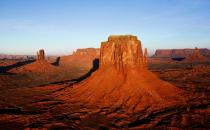
Changing Landscapes - Year 4 CLE

In this Connected Learning Experience, students explore what can shape the natural landscape.
Human activities and the resulting effects on a local surface over time are explored in terms of the consequences for the environment.
This CLE could be taught as part of a cross-curricular unit that incorporates Year 4 HASS content descriptions;
- Stories of the First Fleet, including reasons for the journey, who travelled to Australia, and their experiences following arrival (ACHASSK085)
- The importance of environments, including natural vegetation, to animals and people (ACHASSK088)
Learning intentions:
Students will be able to:
- state that the surface of the Earth changes over time;
- identify human activities which cause changes to the Earth’s surface;
- state that moving water washes away (erodes) soil;
- explain how plants help prevent soil erosion;
- appreciate that science knowledge helps people understand the consequences of their actions;
- follow instructions to identify investigable questions about familiar contexts and predict likely outcomes from investigations;
- make accurate observations; and
- draw conclusions based on evidence.
New Australian Curriculum 9 Codes: AC9S5U02 (Year 5)
Additional Information
A Connected Learning Experience (CLE) is a resource package designed to support the use of inquiry investigations in the classroom.
Each CLE may not encompass all the concepts and skills addressed in the specific content descriptions outlined by the Australian Curriculum: Science for that Year level. The Learning Intentions clearly define the aims and objectives of the CLE.
Year 4 Achievement Standard
This lesson sequence provides opportunities to gather information about students’ achievement of specific components in the standards (which are bolded in the statements below).
By the end of Year 4, students apply the observable properties of materials to explain how objects and materials can be used. They use contact and non-contact forces to describe interactions between objects. They discuss how natural and human processes cause changes to the Earth’s surface. They describe relationships that assist the survival of living things and sequence key stages in the life cycle of a plant or animal. They identify when science is used to ask questions and make predictions. They describe situations where science understanding can influence their own and others’ actions.
Students follow instructions to identify investigable questions about familiar contexts and predict likely outcomes from investigations. They discuss ways to conduct investigations and safely use equipment to make and record observations. They use provided tables and simple column graphs to organise their data and identify patterns in data. Students suggest explanations for observations and compare their findings with their predictions. They suggest reasons why their methods were fair or not. They complete simple reports to communicate their methods and findings.
- Year 4 > Science Inquiry Skills > Planning and conducting > With guidance, plan and conduct scientific investigations to find answers to... > ACSIS065
- Year 4 > Science Inquiry Skills > Processing and analysing data and information > Compare results with predictions, suggesting possible reasons for findings > ACSIS216
- Year 4 > Science Inquiry Skills > Questioning and Predicting > With guidance, identify questions in familiar contexts that can be investigated... > ACSIS064
- Year 4 > Science Understanding > Earth and Space Sciences > Earth’s surface changes over time as a result of natural processes and human... > ACSSU075
- Year 4 > Science as a Human Endeavour > Nature and development of science > Science involves making predictions and describing patterns and relationships > ACSHE061
- Year 4 > Science as a Human Endeavour > Use and influence of science > Science knowledge helps people to understand the effect of their actions > ACSHE062


